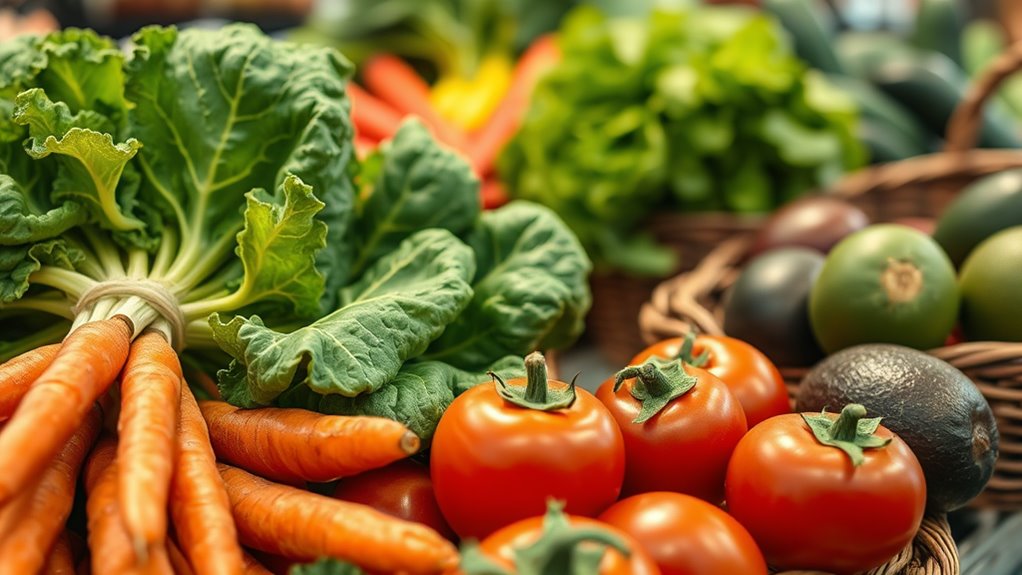How to Spot Truly Nutritious Foods at the Grocery Store
To spot truly nutritious foods at the grocery store, focus on reading labels. Check serving sizes and prioritize items with high fiber, vitamins, and low saturated fats. Look for heart-healthy certifications, indicating products that meet strict nutrition standards. Don’t forget whole grains; make certain they’re listed first in the ingredients. Finally, consider frozen and canned options for their affordability and long shelf life. There’s much more to discover about making smarter choices in your grocery shopping.
Key Takeaways
- Check serving sizes and % Daily Value to gauge nutrient richness and overall caloric intake.
- Look for whole, recognizable ingredients at the top of the ingredient list.
- Seek products with Heart-Check Certification for verified heart-healthy standards.
- Prioritize items with high fiber, calcium, and iron contents for better nutritional quality.
- Consider frozen and canned options for year-round nutrients without sacrificing convenience or cost.
Understanding Heart-Healthy Certifications
When you’re shopping for healthy food options, understanding Heart-Check Certification can help you make informed choices. This certification, based on American Heart Association guidelines, guarantees products meet strict nutrition standards for smart grocery nutrition.
To earn this mark, foods must limit total fat, saturated fat, cholesterol, and sodium, making them healthier options for your heart. For instance, total fat must be less than 6.5 grams per serving, and saturated fat should be 1 gram or less. Additionally, products must meet government regulations for coronary heart disease health claims, ensuring they align with recognized health standards.
Additionally, products undergo lab testing to verify compliance with these criteria, giving you peace of mind. By choosing Heart-Check Certified items, you’re not just shopping smart; you’re also supporting your heart health with every purchase.
Reading Nutrition Labels for Better Choices
Understanding how to read nutrition labels can empower you to make better food choices. Start by checking the serving size since it dictates the amount of calories and nutrients per serving. Use this information to compare products effectively.
Focus on critical nutrients like fiber and vitamins while limiting saturated fats, sodium, and added sugars. Look at the % Daily Value (%DV) to gauge how a food fits into your daily nutrition needs—high %DV means it’s nutrient-rich, while low %DV indicates caution. Additionally, being aware of total calories helps you track your overall energy intake and make informed decisions. Remember that nutrient-dense foods provide more vitamins and minerals relative to their calorie content, making them a better choice for your health.
Finally, scan the ingredient list; ingredients are listed by weight, so the first few are the most significant. Opt for whole, recognizable ingredients and watch out for misleading claims to guarantee you’re choosing truly nutritious foods.
Identifying Whole Grain Foods
Nutrition labels provide a great starting point for making healthier choices, but knowing how to identify whole grain foods is just as important. Look for terms like “100 percent whole grain” or “whole grain” on the packaging. Ingredients should list “whole” grains first, ensuring they’re the primary component. Be cautious with “multigrain,” as it doesn’t guarantee whole grains. Whole grains are linked to lower risk of cardiovascular disease, making them a valuable addition to your diet.
| Label Type | Description |
|---|---|
| 100 Percent Whole Grain | All grains are whole grains, often with a stamp. |
| Whole Grain | At least 51% whole-grain ingredients. |
| Sprouted Grains | Germinated grains that are easier to digest. |
The Benefits of Frozen and Canned Options
Frozen and canned foods offer a convenient way to boost your nutrition without breaking the bank. They’re often more affordable than fresh produce, making them accessible for everyone. Canned vegetables can be half the price of frozen and a fifth of fresh, while frozen options retain nutrients well due to flash freezing at peak ripeness. Additionally, many of these foods are rich in essential vitamins, which can significantly contribute to your overall health. Plus, their long shelf life helps reduce food waste and guarantees you have healthy options on hand year-round. Many canned items are pre-cooked, requiring minimal preparation, and both options cater to various dietary needs. When included in your meals, frozen and canned vegetables can enhance your nutrient intake, making it easier to meet your dietary goals without sacrificing quality. Studies have shown that frequent canned food consumption is associated with higher nutrient intake and better diet quality.
Creating a Healthy Grocery List
When it comes to stocking your kitchen, a well-planned grocery list can make all the difference in maintaining a nutritious diet. Start by focusing on nutrient-dense foods that fuel your body. Incorporating nutrient-rich foods can enhance your beauty from within, contributing to radiant skin and hair.
Here are some essentials to include:
- Fresh fruits like apples and berries for vitamins and antioxidants
- Colorful vegetables such as spinach and sweet potatoes for fiber
- Lean proteins like skinless turkey and low-fat fish for muscle health
- Whole grains like quinoa and brown rice for sustained energy. Making a weekly list can also help ensure you stay on track with healthy eating.
Organize the list by store sections to save time and avoid impulse buys. Plan your meals for the week and don’t forget to incorporate seasonal produce. With a little preparation, you’ll find grocery shopping can be a rewarding experience!
Shopping Strategies for Nutritious Foods
Shopping for nutritious foods can feel overwhelming, especially with so many options available. To make it easier, start by planning your meals for the week. Create a detailed ingredient list based on those meals to keep you focused. Stick to your budget to avoid overspending.
When you’re in the store, shop the perimeter for fresh produce, meats, and dairy, avoiding the processed foods in the inner aisles. Organize your list by store sections to save time, and look for sales on healthy items. Don’t forget to check nutrition labels and ingredient lists for added sugars or preservatives.
Additionally, be aware that many healthy packaged foods may contain misleading health claims due to processing that strips away essential nutrients.
Finally, consider whole, unprocessed foods and prioritize seasonal and local produce for the best taste and value.
Utilizing Technology for Smart Shopping
As you navigate the modern grocery landscape, leveraging technology can transform your shopping experience into a more efficient and personalized journey.
Embrace AI-powered platforms to tailor your grocery list based on your dietary needs and preferences. With features like health tags and real-time recommendations, you can easily identify healthier choices.
Here’s how technology enhances your shopping:
- Personalized suggestions help you discover nutritious alternatives.
- Smart devices streamline your shopping and inventory management.
- Collaboration with health organizations* guarantees *reliable nutrition advice.
- Gamification and rewards motivate you to stick to healthier habits.
Making Informed Decisions on Packaged Foods
Maneuvering the aisles of packaged foods can be overwhelming, especially with so many options vying for your attention.
To make informed decisions, start by examining Nutrition Facts labels. Pay close attention to serving sizes, as they dictate the nutritional values. Look for calories per serving to help manage your daily intake.
Check the % Daily Value (%DV) for key nutrients like fiber, calcium, and iron; higher percentages indicate better nutritional quality. Choose products low in added sugars, sodium, and unhealthy fats.
Always opt for whole, recognizable ingredients over long lists of additives. Don’t be swayed by misleading claims—focus on the actual nutrient content to guarantee you’re making healthier choices for your diet. Additionally, be aware of hidden nutrient deficiencies, as they can significantly affect your health and well-being.
Frequently Asked Questions
What Are the Health Benefits of Choosing Organic Foods?
When you choose organic foods, you’re not just selecting produce; you’re boosting your health. You’ll lower the risk of eczema in infants, reduce exposure to harmful substances, and enjoy better nutrient profiles for your family.
How Can I Determine if a Food Is Truly Gluten-Free?
To determine if a food’s truly gluten-free, check for third-party certifications, read the ingredient list carefully, and watch for cross-contamination warnings. Don’t hesitate to contact manufacturers if you have questions about their products.
Are All Natural Foods Healthy Options?
Imagine grabbing an “all-natural” snack, thinking it’s healthy, but it’s loaded with sugar. Not all natural foods are nutritious; some can still pack unhealthy ingredients. Always check labels to make informed choices about your diet.
What’s the Difference Between Whole Foods and Processed Foods?
Whole foods are unprocessed or minimally processed, retaining their natural state, while processed foods undergo alterations for taste or convenience. Whole foods typically offer more nutrients, while heavily processed options often contain added sugars and unhealthy fats.
How Do I Avoid Misleading Health Claims on Packaging?
Imagine traversing a forest of labels, each promising treasure. To avoid misleading claims, you need a trusty map: read ingredients, question vague terms, and trust your instincts. Healthy choices often hide in plain sight, waiting for you!
References
- https://www.heart.org/en/healthy-living/company-collaboration/heart-check-certification/heart-check-in-the-grocery-store/certified-foods-in-the-grocery-store
- https://manuu.edu.in/dde/sites/default/files/DDE/DDE-SelfLearnmaterial/BA-6thSemester/Englishba6th28may24.pdf
- https://www.heart.org/en/healthy-living/healthy-eating/cooking-skills/shopping/5-easy-ways-to-find-healthier-options-at-the-grocery-store
- https://wac.colostate.edu/books/writingspaces1/writing-spaces-readings-on-writing-vol-1.pdf
- https://www.bluecrossvt.org/health-community/blog/listing/your-healthy-guide-grocery-shopping
- https://www.heart.org/en/healthy-living/company-collaboration/heart-check-certification/heart-check-in-the-grocery-store/heart-check-food-certification-program-nutrition-requirements
- https://www.coursehero.com/tutors-problems/Health-Science/64928095-1-Your-manager-asks-you-to-write-monthly-blog-about-healthy/
- https://www.goredforwomen.org/es/healthy-living/company-collaboration/heart-check-certification/how-a-food-becomes-heart-check-certified
- https://files.eric.ed.gov/fulltext/ED201238.pdf
- https://www.stroke.org/en/healthy-living/healthy-eating/heart-check-foods

